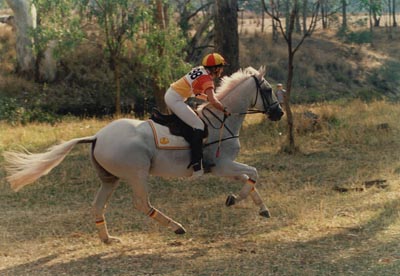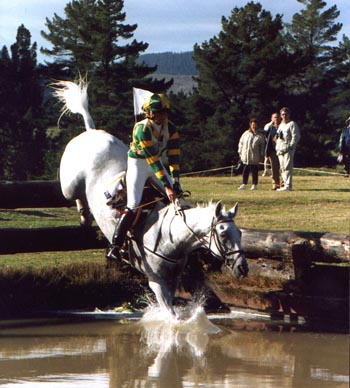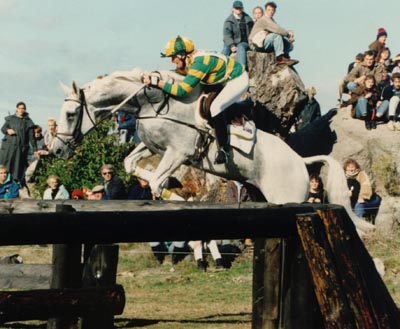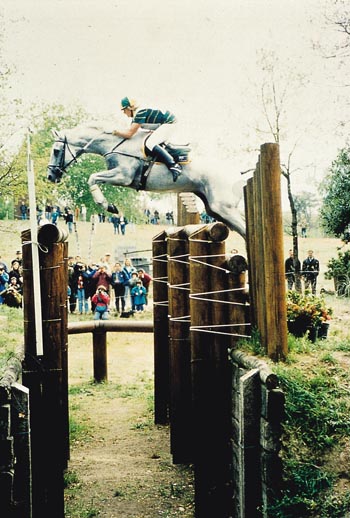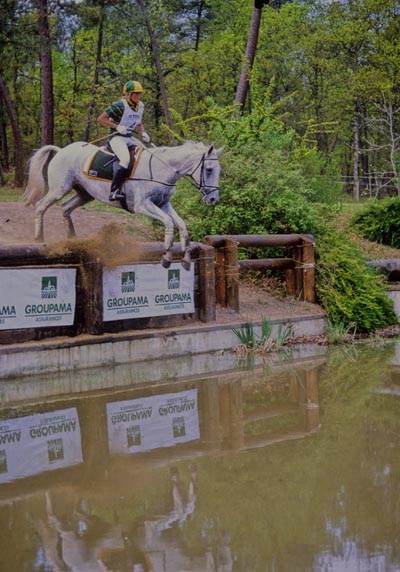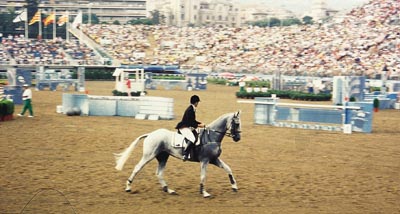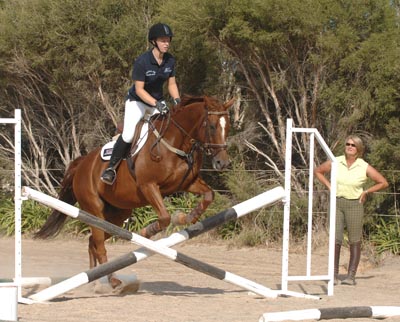Olympic bound…
The next star on Gill’s horizon, was Peppermint Grove, alias ‘Fred’, the horse that was to take her to Olympic gold, a horse that was loved by equestrian fans all over Australia… And like lots of great horses, Fred came about more or less by accident.
By this stage my job was school teaching but also working with quite a few horses, schooling and competing for owners, selling on racetrack jobs lots of teaching– mainly showies … the things you have to do to survive in the horse game, but the next really good one was Fred and he was supposed to be Greg’s next horse…
I married Greg during Adelaide Royal in 1995 – the year before the World Championships at Gawler. He’d been riding his first horse, Rare Vintage (an Anna Creek Station racing reject) for a couple of years and together they kicked around Intermediate Gawler and Melbourne and got to B grade showjumping and jumping at the Royal. Not bad for someone who had not ever sat on a horse before I met him! After a couple of years Vinnie had done his job as school master for Greg so we ended up giving him to 12 year old Wendy Schaeffer as her first graded showjumping horse. Wendy needed another horse to ride at the Royal with her mum’s old eventer, Sunhill Cloud, so we gave Vinnie to Wendy, and she had fun on him for a couple of years, while we looked for another horse for Greg.
We’d heard about a horse three hours north of Adelaide. He was apparently ‘big and ugly and grey and could move a bit’. He was four. He’d been broken in by Peggy Stewart, the girl who owned him, and she was pregnant with her second child. When we went to look at him, she walked around on him and I thought, oh yeah, he’s big enough and, certainly not a show horse so probably good for Greg. Then he started to trot and I thought ‘ooh wait a minute… this is really nice, he really comes off the ground, he had natural rhythm and cadence– oh wow look at him lengthen and still stay uphill and through!’ Then he cantered and he was just so light on his feet. I thought, bad luck Greg.
I asked Peggy if she would she pop him over a jump, and she said, I don’t really like to jump him, he jumps too big. ‘Oh that’s a shame, perhaps you could just pop him over that little log there’. She’s trotted in, he’s gone ‘Kapow’ and practically jumped her off. I think I better have first ride, and that was the end of it for Greg – he was a lovely horse. Two thousand dollars, the most expensive horse I’d bought up ‘til then – they were the good old days.
He had a big scar on his back leg, and I very nearly didn’t buy him, but Peggy was really lovely. She said ‘take him on trial, get him vetted, then if you still want him, you can pay me.’ Perfect. The vet said he was fine. He was wonderful from day one. He was always such a big careful jumper but he ran on confidence. He had to be very confident in what he was doing. If he was worried about a fence, if it was a little spooky, and you put your leg on a little stronger, he’d just jump way bigger – but you didn’t want to break the heart of a horse like that. He had to learn to jump within himself, rather than over-jumping everything. While he went up the grades quickly, I would always back off a little, then go forward once we were really established at the next level. I’d always work him at the level above what he was competing at so that the competitions were actually a lot easier than what we’d been doing in training.
With his jumping, I’d work up to jumping quite complex lines and/or big fences but finish over something simpler or lower so he always finished a session confident. Sometimes with a horse that is so talented and careful you can get a bit greedy and break their heart because they try so hard all the time.
I don’t think he was beaten in his first season, he went up the grades in dressage. I got him up to medium and in showjumping, to B grade. Eventing-wise, he also went up quite quickly. His first Gawler, 1989, where, I think, he came second in the Novice. He’d had about three starts before then. Round about then was when I started to get time penalties – because I was gun shy after what had happened with Saville Row, I started to worry about Fred. With Saville Row, okay you won the dressage, and then went out to win the event. I didn’t even think about the quality of the ground or about not running hard at every start. After Monty hurt himself, I thought, hmm, that’s not such a great plan, it didn’t keep my horse sound for so long.
So I wasn’t going to make the same mistake with Fred. I was criticised for not running hard at every little bunfight, but hey, you have to think about long-term goals. I wanted him sound when he was Advanced – so I’d pick and choose where I ran hard. On our lovely baked ground, my ‘run hards’ were only at the major Three Days. One Days I liked to win, and he was quite successful, but there were times when I didn’t go that fast and I did get criticised, but at the end of the day I had a horse sound enough to go to two Olympic Games and the Worlds, and he still finished sound at 17 yrs of age.
Cross country at Avenel
We were Advanced by the next Gawler in 1990. Fred went straight from Novice to Advanced. We came 4th that Gawler, then spent the rest of the year confirming the dressage at Medium level, jumping B Grade at the Aggie shows and the Royal. By May 1991, we went to Taupo with the Australian squad for the Trans Tasman. There was five of us: Derek Piper on Eurella Jubilee, Andrew Hoy and Kiwi, Heath Ryan on Looking Good, and Peter Haynes on Alcheringa and me. We were away for five weeks.
We did the NZ One Day Championships, up north at Palmerston. We got there and thought she-it! This is serious. It was tough. Lot of corners, big tall brush and bull-finchy things… Peter had a bit of a disaster there so they put me and Fred in the team for Taupo. Fred did a great dressage test at Taupo, winning the test on a 46 with Heath breathing down my neck. Then we went cross-country. He jumped clean but had 12 time – that was the best Australian cross-country result. Jubes had a fall; Kiwi had a runout at a double of Apexes. Heath had a run out at the third fence, the ditch and palisade into a cliff face – it was a nasty fence. That was a Jennifer Miller course and we’d never ever seen so many apexes, ditches or so many arrowheads.
Competing at Taupo in New Zealand
There were all sorts of problems there, but Fred was fantastic– even though we were the best of the Aussies I got my backside kicked for having too many time penalties.
It was a tough course at Taupo
All of a sudden we were in the frame for Barcelona. Then we had to do Melbourne, again probably a little slow, but jumped well and a good test and 7th. I got the call up from Jim Dunn who was the chef d’equipe and Chairman of selectors. OK you are on a list with a chance to go to Barcelona, but the deal was get yourself, your horse, your gear, everything, to England at your own expense. Compete on the circuit over there for six months and if you win enough, and your horse is sound and you survive all that AND you make the team – then we’ll pay to bring the horse home.
What happens if we don’t make the team? Oh well you’ll have to sell the horse or bring it home yourself. It was one of those, do we do it, or do we not? We didn’t have the money for it, but I had total belief in Fred, and so did Greg, so we thought, right we have to have a go. We didn’t want to sit here ten years down the track, saying ‘What if….’ If we were there, then at least we were in contention. Once we were there, then we would have to make sure we did well enough to be selected to make the team to get Fred home.
So we had to find a place to stay, organize the blood tests, all the travel arrangements, in those days, we did everything. We had to find the money and work out how to do it, which is not so easy when you’ve never done anything like that before. It was a very steep learning curve. I went over in March, and Greg took leave of absence from school to come over later. He got there in May. It was tough. Before leaving, thanks to some great supporters and friends, we ran a huge fundraiser and that was amazing. So many people came along to a huge marquee at Reynella Horse Trials Venue for a big party to support Fred (mainly) and me. It was amazing! We got the money together for the airfares and help from other friends, so on the 3rd of March 1992, off we went.
I was based with some lovely people, the Shepherds in Little Cheverell, near Devises. I’d met Jacquie their daughter while I was staying with Vicki and Wayne Roycroft and she said that if ever I was in the UK to look her up. So we did. The Shepherds raced Arabs and had a couple of steeplechasers. It was a great area, right on the Salisbury Plains, fantastic for galloping and fitness work – but not so flash for the dressage and jumping as there was no arena there. I used to have to hack down the road a couple of miles to find a 20 by 40 to ride in. No jumps, I just had to go to comps to train jumping, which was fun anyway! Money was very tight, so with the odd showjumping win, Fred ate better than I did, which probably wasn’t a bad thing…
When you put your life on the line like that, you have to make it work, it makes you more determined to make it happen. Sometimes things wouldn’t go well for whatever reason, I’d feel homesick and lost, I’d think why am I doing this on the other side of the world without family and friends for support? I’d feel sorry for myself and want to slash my wrists. Then I’d think, how stupid am I? Here I am competing in the UK with my fantastic Fred. I may feel out of my comfort zone but so what, I’ve got my chance, I’ve got to make the most of it, to get off my butt and chase that dream!
Making a bid for selection at Saumur
The French National Championships at Saumur was to be our major selection event in the UK as it was suggested that Saumur was a better lead up to the Games than Badminton in the Olympic year (it’s a a bit different to these days!) The night before leaving for the event, Fred put his foot in a haynet. Stupid me, I didn’t tie the haynet up well enough, he played with it over night, got his foot in and wrenched a fetlock, so he wasn’t quite 100% on the morning we left. He wasn’t bad, but standing in ice all the way over to France wasn’t the most comfortable way to travel.
He passed the trot up fine – the only one of the Aussies that didn’t go to the hold box, as it turned out! He did a fantastic test and was leading after the first day of dressage – and was still there at the end of the second! There were 90 in the class, including the then world champion, Blyth Tait, Eventing legends Mark Todd and Mary King as well as Andrew Hoy, Stuart Tinney and David Green. I didn’t want to run hard, because of the fetlock – but when you are in the lead, that’s what everyone expects you to do. There was some pretty rough ground at the end of the track – he jumped super all the way around, and I just took a bit of a pull when I came to the bad going and picked up a few time penalties, and although he show jumped well, we dropped down to 7th.
For me it wasn’t a disaster. I was pretty happy about the whole thing and he pulled up sound. But coach Wayne Roycroft wasn’t happy, he told me that I wasn’t a winner, and to sell Fred to one of those many people who were offering us big money and ‘go off and have babies – that’s probably all you are good for!’ Harsh words but that’s Wayne’s way of making you tougher. He could see that maybe I wasn’t as tough as I needed to be, and that was his way of making me tough. You’ll find that the best coaches around will try and find people’s weaknesses, and work on those weaknesses to make them strengths. It did give me the incentive to prove him wrong and make the team!
In the end the team was decided pretty much on soundness. Stuart came second at Saumur on Eurimbla Bright Beacon. He was down the track a little after the dressage but he came in exactly on optimum time and showjumped well. While he was 2nd at Saumur, the horse wasn’t sound for Barcelona. My goal wasn’t to win Saumur, especially when the horse wasn’t quite 100% – my goal was Barcelona and the Olympic Games. I learned many years before that you sometimes had to forsake short term glory for those long term goals.
Four weeks later I went to the big Jumping Derby at Hickstead, and won an AM7 foxhunter class (1.25m) and came fourth out of a 100 or so starters in the Eventers Special. That was a metre thirty track for the top 20 qualifiers on the main arena and included the Devil’s Dyke, the Liverpools, banks and ditches – a real tough Derby course. It was a great event, everyone was there: Toddy, Blyth, Ian Stark on his amazingly scopey grey, Murphy Himself and Fred was a star. I even had the showjumpers coming up offering me quite big money for him. And I got to ride on the same warm up arena as Milton. Was he ever an amazing jumper in the flesh!
We did a number of One Day Events, and usually placed, competed dressage at local West Wilts Equestrian Centre where UK based Swiss Eventer Christian Landolt (now an Olympic judge) and I would fight it out for first place in the medium tests against the Dressage Queens. Then it was off to Savernake Forest which was the final selection trial. Freddie was the highest placed Aussie horse there.
It was a very strange weekend to pack for. It was either pack everything to be ready to go straight into training camp and on to the Games, or pack nothing and go home and get ready to sell your horse. I packed for nothing because I didn’t want to tempt fate, but after that event we were definitely getting a berth – as reserve rider. There were no illusions about actually riding in the team, it was come along to Camp but you are the reserve rider. As things turned out, Greg Watson’s horse had a bit of a leg, and Fred got his chance. They didn’t want a ‘girl’ in the team, and they weren’t keen on Matt Ryan and Kibah Tick Toc either. Matt had been to Badminton, did a great test and was fantastic in his cross-country, then had five rails in the showjumping. Not an ideal selection performance. As it turned out they had to take the pair of us – and Matt did a sensational job.
We all didn’t pull off as good a test as our lead up events had promised and the Aussies were in 6th but this wasn’t going to be won on the dressage. The cross country was long and tough, the weather hot and humid and there were lots of problems out there. Clear rounds were the exception not the rule.
Cross country at Barcelona
After the cross country at Barcelona, we knew that our horses had pulled up really well, and there were lots of others that hadn’t. Our vet Denis Goulding – ‘Bear’ – was our secret weapon. Bear knew how to get those horses re-hydrated in the heat. At the finishing there were horses gasping and tottering all over the place, no one had a real understanding of the effects of the humidity and the heat. But Bear was on to it, he had buckets of iced water. He also got fluids into them quickly, which was allowable under the rules but no-one thought of it. He was right on to it. My major concern with Fred was that he had lost a shoe in the steeplechase, and we had to wait in the box to get a shoe put on. There were a couple of nails that never came out to start with, so we were just a tad worried…
The Australian horses came out bright-as for the trot up and the showjumping, We were in third going into the trot up, then we were in second after the trot up when they spun Ian Stark’s horse, Murphy Himself.
In the showjumping, I had a rush of blood going into the final treble and had one down, but the rest was super. It was the first time I’d ever ridden an open water jump… Olympic Games, here’s this 13’ open water related to planks, and all the fences various shades of blue grey not at all like the normal showjumping track. This will be interesting. Fred didn’t care, he just jumped his usual big careful round.
Showjumping for gold at Barcelona
So I had one down, Andrew Hoy and Kiwi had one down. The NZ team were having rails all over the place, then Andrew Nicholson had 8… and we thought this is getting quite exciting. Matt went out, and if he jumped clear or one rail, he had his gold medal. We were thinking about him and his gold medal, not a gold medal for us. He did a sensational job and just one fence down. Thank god it was the last one, not the first one – and all of a sudden the calculations were done, and we were in the lead for team gold by 1.2. We went crazy.
There were two absolute standout moments for me at the Games. The first was entering the stadium. Wow, the reality hit that I was actually at the Games, and the reality that all that hard work and belief was for something. It was euphoric. Until then we spent most of the time two hours away up the hill with the horses, not in the Games village, and it was just like another competition. At the opening ceremony we had no idea what was going to happen. We were down in tunnels (the bowels of the earth?) waiting to come up into the stadium, and all of a sudden you burst into the place, surrounded by 100,000 people cheering and clapping, it gave you such a kick. It was as we were marching that I actually found out I was riding. Right at the last minute and what a way to find out!
And of course, the other moment that will live forever was when we realised that we had won a gold medal… and we galloped madly around the stadium feeling like we owned the earth!
Charlie’s lesson over jumps
As Gill sees it, Charlie has to work on two things: her body and leg position, and her horse’s way of going:
Apart from the way the horse jumps, Charlie likes to look down over a fence, and her upper body topples forward. The horse has quite a nice back end over a fence, so he does tend to kick her that way a little. When he lands, she lands looking down tipping forward, and takes three or four strides to get herself back up again, re-balanced and re-organized.
I’ve been talking to her about what she has been doing over in Tassie. She said, the horse usually goes around pretty well but he does fight me and have the odd runout at skinnies, especially after a water or bank. Ah, it wouldn’t be because you are leaning forward looking down with an unstable lower leg and not sitting up in time to balance for the out? Oh, yes, probably that’s it…
In showjumping when she has a related line, or a double or treble on a waiting distance, she often has the front rail on the way out because she can’t keep the horse together enough for the out. Again, that is because he jumps in big and she tends to tip her body forward and take three strides before she is balanced enough to adjust him, so she is on his head trying to adjust on the last stride or as they are taking off, as opposed to getting it early so she can ride to the fence. We need to get her thinking about the landing and keeping her heels down and shoulders up, to help re-balance the horse through the line of fences.
She has to concentrate on keeping her eye up to keep her shoulders up, and keep her eye up on a focal point. It probably didn’t come out a lot in this lesson, but the lesson before we had a line with a particular tree at the end of the arena, with Charlie keeping her eye on that tree so she had a definite focal point to aim for through the turn and through the line but at the same time, she must be aware of where all the fences are with her peripheral vision. I don’t want her looking down at the fences; I want her looking up at the top rail and through the back rail towards where she is going, keeping her eye up so she is not tipping forward.
The other thing she does is that she collapses through the stomach and tips forwards with the shoulders. She isn’t disciplined with her upper body and through her abs, to stay up – whether it is on the flat or whether it be jumping. She tends to throw her body forward, she tends to grip with her knee and the lower leg swings back. We are working on trying to stabilize her lower leg position, trying to keep her shoulders up, keep her focal point up.
Her lower leg position has improved amazingly since she arrived. At first she was really gripping with her knee and keeping her leg off the horse. She thought because he is a hot horse he wouldn’t let her have her leg on. The opposite is actually true. He becomes more confident with a consistent and educated leg on him. Not this unstable no-leg-then-kick routine. I’ve been making her ride without stirrups on the flat, and also a little without stirrups in her jumping saddle over little fences and rails, just so that she can keep her lower leg on and realise that the horse isn’t nicking off.
In this photo Charlie is keeping her shoulders up, her lower leg is a little too far back and her arms are a little low, but she is keeping her eye up, the shoulders are up and she is not collapsing through her stomach. I’d like to see a little more angle through her hip but that is pretty good for her at the moment…
That’s actually quite good, she is really keeping her eye up and her lower leg is on. She’s keeping her shoulders up and her heel down a little bit and the lower leg is closed. She is giving quite a nice elastic feel on his mouth. She needs to be able to do that over a bigger fence now.
She could just be coming a bit more into a light three point, she is still a fraction too far forward – I’d like to see her sitting up through the shoulders and not leaning down on her hands too much.
I like the focal point. I think the focal point is quite good. She could have a little more release through the elbows and I think her body is still too far down with her shoulders. The good thing is that she is not collapsing totally through her stomach, but I’d like the shoulders fractionally up from there, and a more traditional release. But it is not too bad.
How do we improve lower leg and heel – does it just come because the instructor keeps saying ‘remember your lower leg and heel?’ Or are there exercises?
Definitely Exercises. There is no point just saying get your heels down. There has to be a why and a how. I do quite a lot of work in two point. Not because I expect them to jump everything out of two point but because it is a means to an end to get more stability of the lower leg. You get them to make sure that they can take the knee off the saddle to make sure that the knee is not gripping. Make sure that the lower leg cuddles the horse. And you make sure they use the stirrup as a fulcrum to allow the heel to come deeper.
I try and make sure they understand why. We don’t just say put your heel down. We say, relax though the ankle, let the weight come down into the heel, stabilize the lower leg by cuddling the horse with the calf. Try and make sure that the ankle is like a shock absorber. All three joints, ankle – knee – hip, have to be like a shock absorber, and the more they work in two point, the more they start to be able to relax into that position. I do quite a lot in trot (despite their cries of pain!) because then they have to become more supple and relax down through the heel, which then gives them the ability to be more stable with the lower leg. Most of them hate doing it to start with because they may be quite sore the next day – due to using and stretching muscles that are often not worked enough. They can be quuite sore in the lower back and the Achilles tendon, and sometimes in the ankle, especially if they have quite rigid ankles.
I also get my students to do dumb things like walk around on their heels with their toes up when they are walking around in the stables, or stand on a brick and lift up from their toes and then lower down through their heel, just to get more mobility.
Or I get them to drop their feet out of the stirrups, and point the toe right down, then up. It is just a mobility exercise for the ankle but they have to keep the lower leg in the correct position. All those things allow the base of support to become more stable, they are things that most kids don’t think of doing until they are told to go away and do some homework. And it does make such a difference to the fitness and position of the rider..
And for the upper body?
“Again I get them to move through a series of exercises breaking it down to the basics then putting it together. So for example they can go around on the circle establishing an active rhythmic rising trot, then into a balanced two point – and be able to maintain the rhythm and activity. Then show me a release, then back into three point, re-find your seat bones and come back to an upright sitting trot. So they start to think of keeping their shoulders tall while doing these exercises. Or, even at the halt you can put them in the position you need, get them into two point, release, rebalance – do it at halt, walk, trot, canter – make them aware of what their body is doing. Then you start to put it together with rails, cross rails, gymnastic exercises, like simple grids, rail cross, one stride vertical, two strides oxer, sequences of bounces – the exercises are endless really but the whole time making them think – keep the eye up on where they are going, because the first thing that makes a rider collapse, is the eye going down.
Keep the eye up. Keeping the shoulders up, and into that two point with ear-shoulder-knee-toe in line over simple jumps, so they get into the habit of staying in balance and riding correctly. I feel that a lot of the time they are lacking discipline, they just want to gallop around and go out and jump… not that there’s anything wrong with that in moderation!!!
Charlie will tell you that. She has never thought about keeping the horse round and making it adjustable when she went to gallop. Or do a warm-up to produce a good rideable canter before she jumps. She never thought about doing a circle after a jump to get back to being balanced – or to think about her position. You have to be in the habit of doing it right. I break it right down, get them comfortable, and then start putting some fences into it. I don’t spend forever trying to make it perfect.
You also have to give them some exercises with some reasonable sized fences, which is why I put Charlie over a little course at the end of her lesson. She’s got a competition next weekend, she needs to jump, we need to make sure she can get the horse operating at competition standard while she is still thinking about trying to make her style better. It has got to be a balance of trying to knock off the rough edges, but still get out there and do the competition.
How much of it is a factor of personal physical fitness?
A rider should always be able to make the horse’s job easier or better – not hinder it because they are overweight or out of condition. The best way to be fit for riding is the specificity training of riding a lot of horses every day, but not everyone has the luxury of having a lot of horses at their disposal to ride.
I think working out in a gym is good. I feel I was the most physically capable of riding well when I was doing karate. I was very fit and supple – essential qualities to riding well. Karate was very good for body awareness and suppleness in the Cata’s (slow motion fighting techniques ). We did a lot of work on breathing, core stability, flexibility, and balance. The strength work was in the fun bit, the sparing – fighting not bathing! Though a spa would have been a very good finish to the session on more than one occasion.
I have to say, I think pushing tons of weight isn’t necessary – or helpful, but certainly the cardio work, bike, rowing , running, skipping, swimming, is good for basic cardio fitness, but nothing beats actually riding – a lot – and well.
Lower leg is quite nice, I’d like to have her again more flexible through the hips, and another problem is this locked elbow and really low hands – like she is trying to hold his head down. It can be a bit of an eventer thing and it is something she needs to really work on because there is no subtlety in any of your work if you’ve got a locked straight arm. We may get beginner riders to keep their hands very low for stability and support but as the rider improves we need a bend through the elbow so you can establish a feel. So I would like to see her hands fractionally higher but not way up, and I would like to see the straight line from the bit through to her elbow, even when she is in a two-point position.
I like the body folded through the hip, the lower leg is on and actually quite nice, the toe is higher than the heel, if anything it could be a fraction more forward but you’ve got a pretty reasonable shoulder-knee-toe line – that’s a good line.
What happens on course is a reflection of the problems they have on the flat. Whenever you put jumps into the equation then you are going to find that the problems they do have on the flat are going to be magnified .You can see that with Charlie and Twistie when he goes to the right.
When she jumps and lands wanting to go right, Twistie will land on his left lead most of the time because she likes to lock with her left side and sit out to the left. She needs to think about that when she is on top of the fence, by looking slightly to the right and even think of a slightly opening right rein and getting more weight into her right heel to get the horse to land on the right lead. And if that doesn’t happen she’s got to do something quickly to get it on the right lead if she is on a course. I was asking her there to think of leg yielding – in other words, making her right leg longer, pushing the horse away from her right leg into the left rein a little bit to stop it from dropping the right shoulder through the turn. What he does, is as soon as he lands, she lets him fall against her right leg, he drops his right shoulder, and he’s on the left lead. She has to get him up, off her right leg, and then ask for the change with the left leg back. .
If she tries to ask for the change when he is leaning through the shoulder, then she is not going to get a change through. She was finding that she puts her left leg back and gets a change, but she is still blocking him in front – so he changes behind and is late in front. She has to think of leg yield for one or two strides on landing to get him up and balanced, and then put her outside leg back to ask for the change. At least he does change, eventually, but she needs to work on getting it through quicker to re-establish the better quality canter through the turn and to the next fence.
At home, she needs to get the change happening, and she is much better staying on a circle until she has him set up to do the change correctly, than coming around totally unbalanced and into a line of fences. Get it organized, and then come on to the line. I know she can get away with it in a competition but at home she needs to get it correct, or her way forward is blocked and there’s no way to get better to handle bigger tougher courses.




